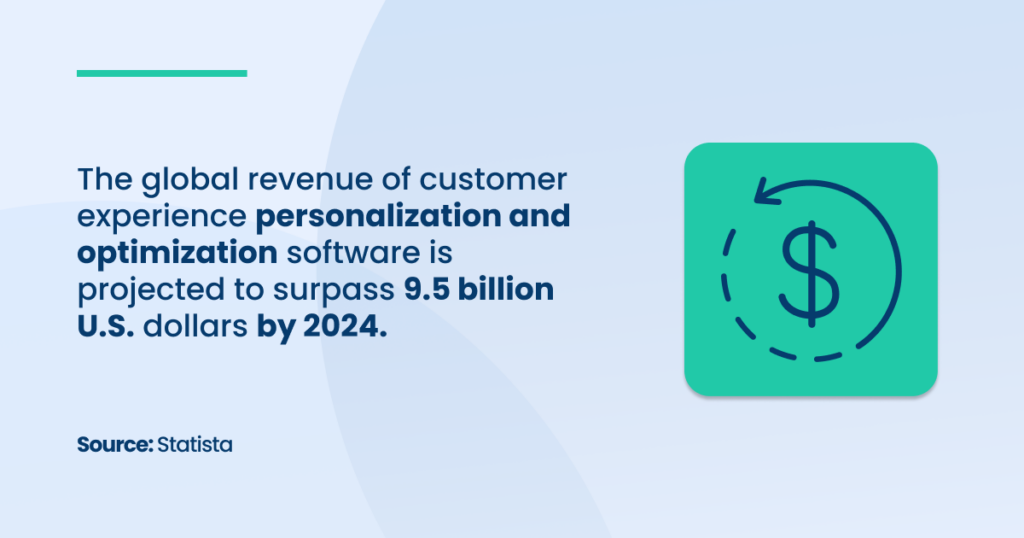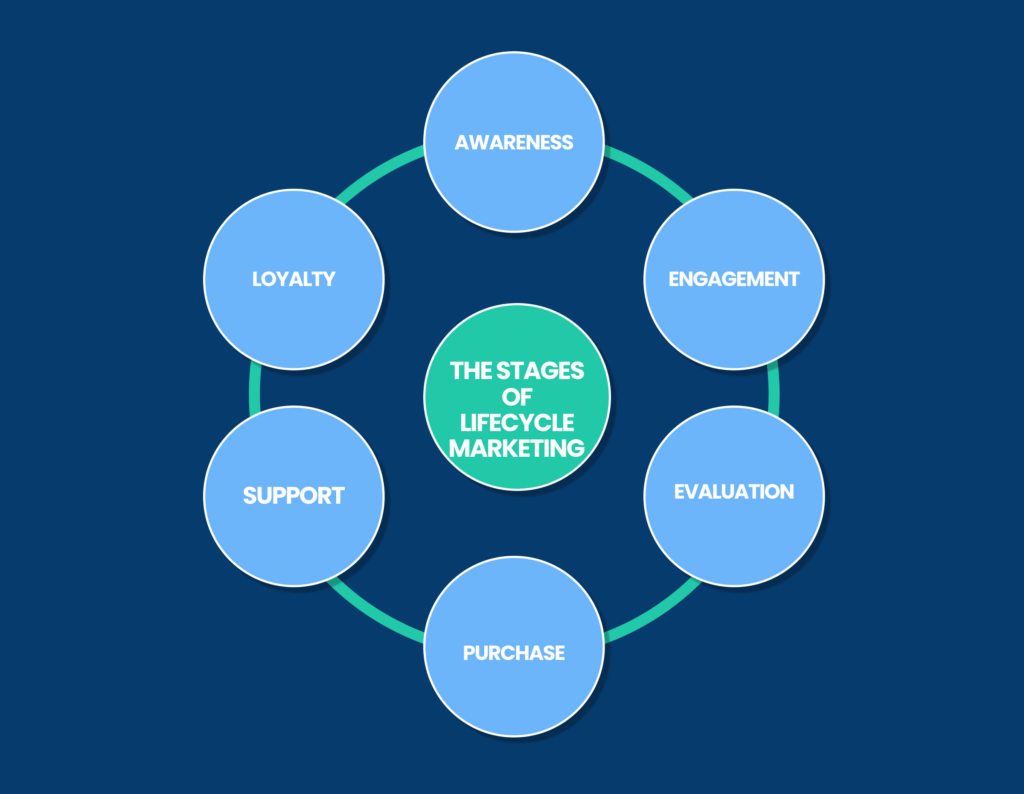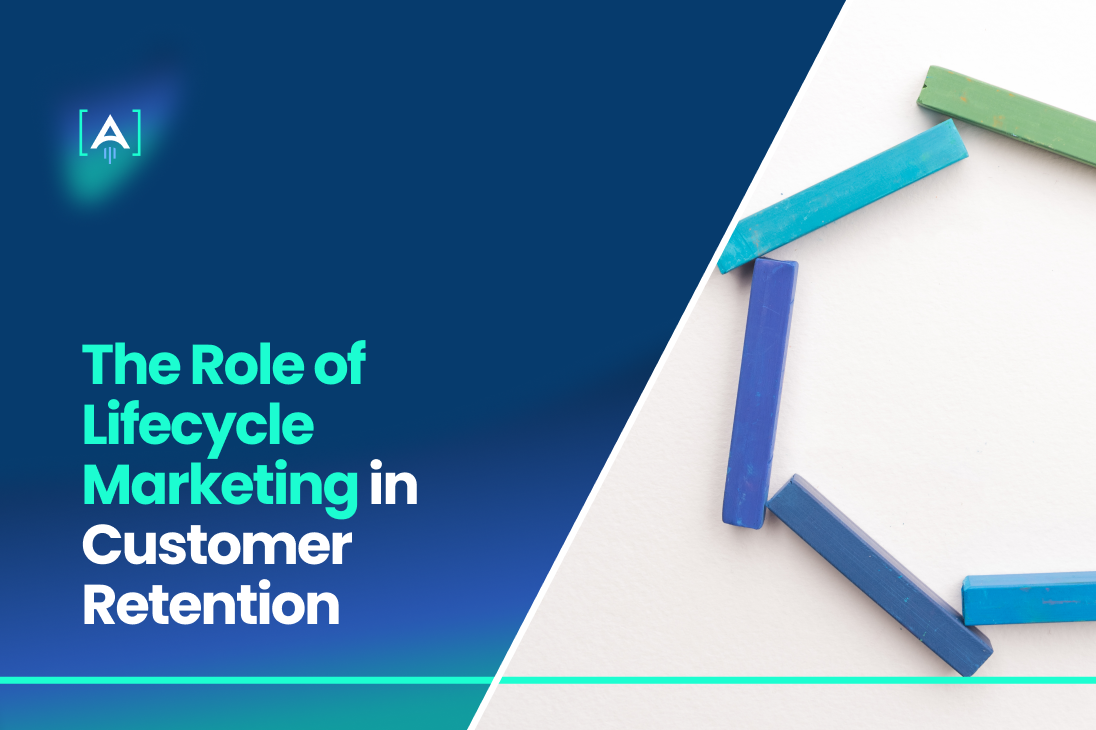In the digital age, where consumers are overwhelmed with information, standing out is crucial.
Traditional marketing strategies often fail to capture the attention of today’s savvy audience.
This is where lifecycle marketing automation comes into play.
Imagine a world where your marketing efforts are synchronized with each customer’s journey, from the initial touchpoint to the post-purchase stage.
Lifecycle marketing automation allows you to do just that.
Statista notes that global marketing automation industry revenue will rise an estimated 12.6 percent to over eight billion U.S. dollars in 2024.
Source: Marketing automation market revenue worldwide from 2023 to 2032, Statista
That annual value was projected to double by 2032, surpassing 21 billion dollars.
In response to this growth, many businesses are turning to Fractional CMO Agency to capitalize on these expanding market opportunities efficiently.
The blog post will cover the foundational aspects of lifecycle marketing but also provide guidance on implementation, challenges, and measuring success.
Understanding Lifecycle Marketing
Lifecycle marketing is a strategic approach that focuses on creating personalized marketing communications based on the specific stages of a customer’s lifecycle.
Employing data-driven personalization helps businesses maximize engagement and retention by delivering relevant messages tailored to each key phase of the customer journey.

Companies can enhance customer lifetime value and foster long-term loyalty by understanding and influencing the customer experience from initial awareness to post-purchase and beyond.
Segmenting Your Audience
Segmenting your audience is fundamental to crafting an effective customer lifecycle marketing strategy.
By employing integrated marketing solutions, businesses can create more targeted and relevant marketing efforts by dividing the audience into distinct groups based on specific criteria.
This approach ensures consistency and coherence across all marketing channels, enhancing the overall effectiveness of the strategy.
This not only enhances the effectiveness of campaigns but also improves customer satisfaction and retention.
Methods for Segmenting Based on Behavior and Demographics
Market segmentation analysis involves categorizing your audience based on various demographic factors such as age, gender, geographic location, income level, and behavioral data, including purchase history, website engagement, and product usage.
Marketing automation software plays a critical role in this process by collecting and analyzing data from customer interactions across all touchpoints.
This data provides valuable insights that help in identifying patterns and trends, which can be used to create precise audience segments.
For instance, a business might identify a segment of existing customers who frequently purchase a particular type of product and target them with specific promotions.
Personalized Communication
Personalized communication is key to deepening customer relationships and driving loyalty.
By addressing customers more personally at each stage of the customer lifecycle, companies can significantly enhance the overall customer experience, leading to higher customer lifetime value.
Source: Mckinsey Research
Importance of Personalized Messages at Each Lifecycle Stage
The importance of personalized messages cannot be overstated, particularly when considering customers’ diverse needs and expectations at different stages of the customer journey.
Employing competitive differentiation through tailored communications allows a brand to stand out by meeting these varied needs more effectively than competitors.
For instance, new customers in the awareness stage might need more general information and reassurance. In contrast, those in the retention stage might appreciate offers tailored to their preferences or past purchasing behavior.
Personalized communication fosters a sense of being valued and understood, which is crucial for building long-term relationships.
A fractional CMO or CMO as a service can be instrumental in developing these personalized strategies, leveraging their expertise to ensure that communications are effectively customized.
Implementing Lifecycle Marketing
Implementing lifecycle marketing effectively requires a deep understanding of the tools and strategies that drive customer engagement at every stage of their journey.
Source: Moengage
Leveraging the right technologies and integrating these into a cohesive marketing strategy are fundamental steps.
Tools and Technologies
The cornerstone of successful lifecycle marketing automation lies in adopting advanced CRM systems and marketing automation tools.
These systems serve as the backbone for collecting, analyzing, and acting on consumer behavior analytics, which are crucial for crafting personalized customer experiences.
CRM systems gather detailed customer data from various touchpoints and integrate this information to provide a comprehensive view of each customer.
This data includes demographic details, interaction history, purchasing behavior, and preferences.
Marketing automation tools complement CRM systems by enabling businesses to execute predefined marketing actions based on triggers or customer actions, such as sending a welcome email upon signing up or a discount offer if a customer abandons a cart.
This automation supports consistent and timely communication with customers, which is essential for maintaining engagement and efficiently moving customers through the lifecycle stages.
Tools like HubSpot or Salesforce integrate seamlessly with various digital channels, enhancing an omnichannel marketing strategy that ensures consistent messaging across all platforms.
Lifecycle Marketing Strategy
Lifecycle marketing strategy is fundamental to a business’s success, serving as a core component that influences customer interaction with a brand across various stages

Properly implemented, it ensures that not only does the business attract the right leads, but it also maximizes the budget by converting those leads into loyal brand advocates.
With a strong strategy, you can grow your customer base by enhancing the buying experience, improve sales by turning one-time buyers into repeat customers, transform buyers into vocal brand advocates, and notably increase your marketing ROI and customer lifetime value.
The efficacy of a lifecycle marketing strategy hinges on understanding how consumers interact with your brand at each lifecycle stage.
1. Awareness
At this initial stage, the goal is to attract as many people as possible within your target audience. Creating highly visible, shareable content is critical. Awareness strategies might include:
- Develop targeted audiences for each buyer persona to ensure the people you attract fit your buyer profile.
- Conducting thorough market segmentation analysis and using researched keywords to help people discover your brand when they search online.
- Producing blog posts that address common questions or problems your audience might have.
- Employing an omnichannel marketing strategy that includes eye-catching social media ads, outdoor advertising in strategic locations, engaging podcast ads, and collaborations with influencers followed by your target audience.
2. Engagement
At the engagement stage, the strategy revolves around sharing information about your offerings to showcase why your brand stands out. Effective engagement strategies include:
- Designing landing pages that are not only engaging but also easy to navigate.
- Using video demos to highlight your product’s features.
- Creating content like blog posts, guides, or templates that solve common customer issues.
- Developing whitepapers that provide deep insights into industry trends or research.
- Crafting case studies that emphasize the positive experiences of your current customers.
- Running targeted email campaigns that preemptively address potential customer concerns.
3. Conversion
Once you’ve managed to impress a potential buyer, the next step is to facilitate their transition from prospect to customer as smoothly as possible. Conversion strategies include:
- Providing clear, accessible pricing and detailed feature information to aid comparison.
- Sharing customer testimonials to foster trust.
- Offering demos or free trials to boost confidence in your product.
- Crafting targeted emails that address potential questions from decision-makers.
4. Retention
Although often overlooked in favor of lead generation optimization, retention is where a significant portion of your marketing effort should be directed. Customers who receive excellent post-purchase service are more likely to make repeat purchases. Retention efforts can be supported by:
- Setting up user-friendly support options like live chat or FAQs.
- Providing onboarding materials that simplify product setup and usage.
- Offering perks or discounts for future purchases.
- Announcing new products or exclusives to existing customers.
5. Loyalty
The loyalty stage is crucial for turning satisfied customers into active brand advocates. Effective loyalty strategies include:
- Offering exclusive features or memberships.
- Providing incentives for sharing testimonials.
Measuring the Impact of Lifecycle Marketing
To understand the effectiveness of your lifecycle marketing strategies, it’s crucial to track specific metrics that reflect the customer’s journey through your lifecycle marketing campaigns.
Source: Moengage
These metrics not only provide insights into the success of your strategies but also offer data-driven feedback that can be used to optimize future efforts.
Key Metrics to Track
The efficacy of lifecycle marketing can be gauged by analyzing a variety of key performance indicators that reflect different aspects of the customer journey. These metrics include Customer Lifetime Value (CLV), repeat purchase rates, and various engagement metrics.
By leveraging lifecycle marketing automation tools, you can accurately track these metrics, allowing for a comprehensive analysis of how well your lifecycle marketing strategies are performing.
- Customer Lifetime Value (CLV): CLV measures the total revenue a business can reasonably expect from a single customer account throughout the business relationship.
It’s a crucial metric for understanding the long-term value of marketing strategies and helps in making informed decisions about how much money to invest in acquiring and retaining customers. - Repeat Purchase Rates: This metric indicates the percentage of customers who come back to make additional purchases.
High repeat purchase rates are often a direct reflection of successful customer retention strategies and are vital for sustaining business growth. Tracking this metric helps in identifying the effectiveness of specific lifecycle stages aimed at encouraging repeat business. - Engagement Metrics: These include metrics like open rates and click-through rates in lifecycle email marketing, session duration on your website, social media interactions, and other indicators of customer engagement.
High engagement rates generally suggest that the content and communications are well-targeted and resonate with your audience.
Customer Lifetime Value (CLV)
Calculating Customer Lifetime Value involves several variables that account for the average purchase value, purchase frequency, and customer lifespan.
This metric is essential for lifecycle marketing as it helps prioritize resources and tailor marketing efforts to customer segments that offer the highest return on investment.
Lifecycle marketing automation plays a crucial role here by providing the data needed to calculate CLV accurately, enabling marketers to refine their lifecycle marketing strategies effectively.
To enhance CLV, businesses can implement targeted lifecycle marketing campaigns designed to boost engagement and encourage higher spending.
For instance, by analyzing the customer lifecycle model, businesses can identify critical points where targeted interventions can increase customer spend or engagement, thereby increasing the overall lifetime value.
Repeat Purchase Rates
A key indicator of customer loyalty and satisfaction, repeat purchase rates measure how often customers return to make additional purchases.
High repeat rates are often the result of effective lifecycle marketing campaigns that focus on retention strategies such as personalized offers, loyalty programs, and regular customer feedback loops.
To improve these rates, businesses can use lifecycle email marketing to send personalized communications based on previous purchasing behaviors, preferences, and customer feedback.
These communications keep your brand top of mind and encourage customers to return more frequently, thereby boosting the company’s lifetime value.
Engagement Metrics
Engagement metrics are critical for assessing the effectiveness of content and strategies at each stage of the customer lifecycle. These metrics provide insights into how customers interact with your brand, which in turn helps refine your messaging and offers.
Email open rates, click rates, page views, time on site, and social media interactions are valuable indicators of your customers’ engagement with your brand.
Lifecycle marketing automation tools can greatly enhance the monitoring of these metrics by automating the collection and analysis of data across different channels and campaigns.
This saves time and provides more accurate and timely insights, which are essential for quickly adjusting strategies in response to customer behaviors.
By consistently measuring these key metrics, businesses can ensure that their lifecycle marketing strategies are not only effective but also continuously optimized to meet their customers’ evolving needs.
This ongoing evaluation and adjustment ultimately drive success in lifecycle marketing, enhancing customer satisfaction and the overall profitability of the business.
Partner with [A] Growth Agency for Your Lifecycle Marketing Strategy
Lifecycle marketing automation is a powerful tool that can transform your business. By tailoring your marketing efforts to each customer’s journey, you can create personalized experiences.
[A] Growth Agency will accomplish the full potential of automation and position your business for long-term success in the competitive digital landscape.
We design a Growth Roadmap encompassing the vision, strategy, and tactics your business needs to grow.
Our experienced team will focus on data-driven insights, continuous optimization, and customer-centric approaches.
Remember, Excellence is our standard.
It is high time!

